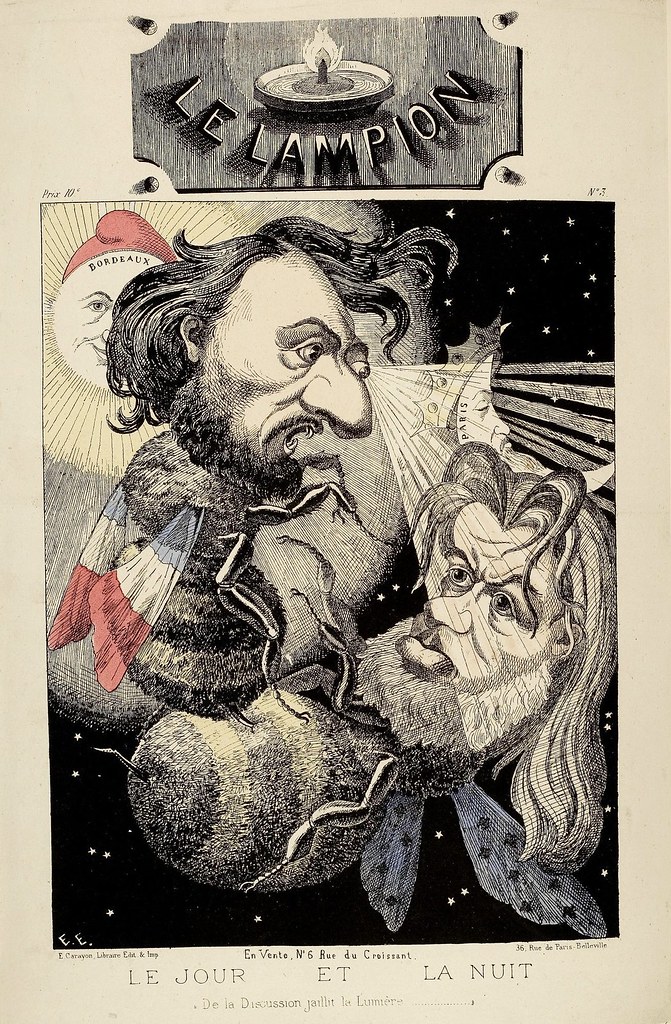
'Le Lampion' - Le Jour et La Nuit
~ The day and the night - The discussion light shines
(depicting Léon Gambetta and Jules Favre)
~ The day and the night - The discussion light shines
(depicting Léon Gambetta and Jules Favre)
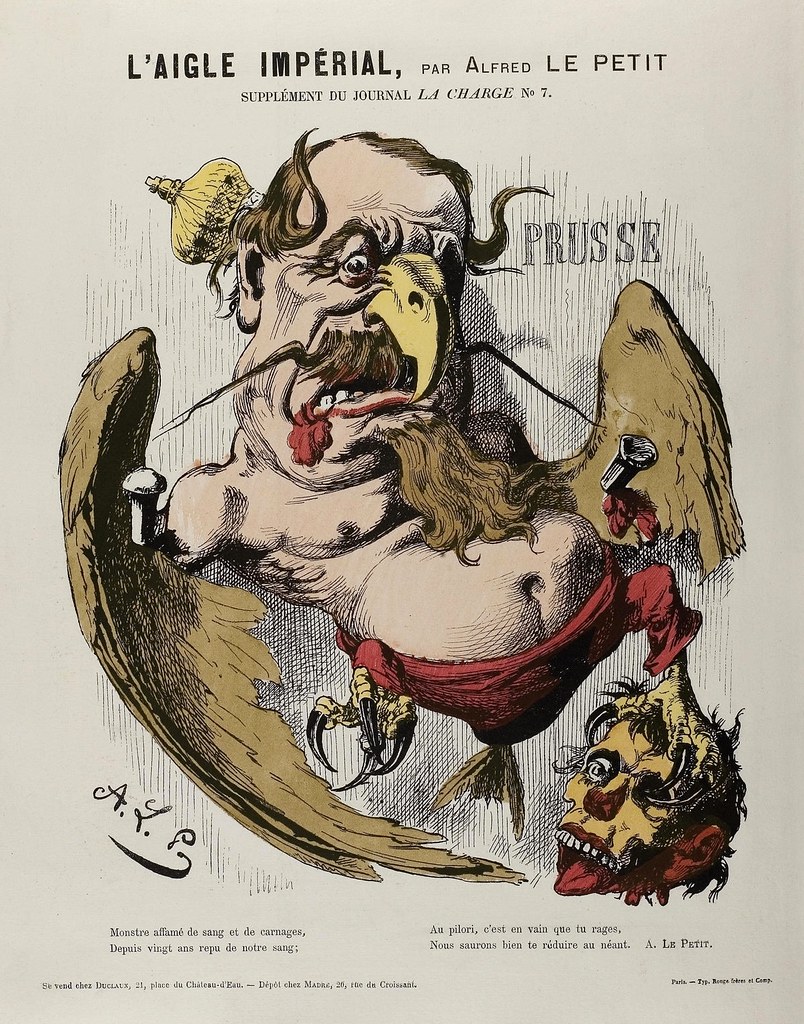
L'Aigle Imperial
(The Imperial Eagle)
(The Imperial Eagle)
Monstre affamé de sang et de carnages,
Depuis vingt ans repu de notre sang;
Au pilori, c'est envain que tu rages,
Nous saurons bien te réduire au néant
Monster hungry for blood and carnage
For twenty years sated with our blood;
Pillory is vain that you crave,
We shall soon reduce you to nothing [web trans.]
Hand-coloured engraving of Napoleon III as half human and half eagle, with a decomposing human head in his talon; intended to show Napoleon as wicked and as lusting after blood as the Prussians. The eagle was a Napoleonic as well as Prussian symbol that illustrators intentionally conflated.
The caricaturist, Alfred Le Petit, published the illustration in his magazine, 'La Charge', which he founded in 1870.
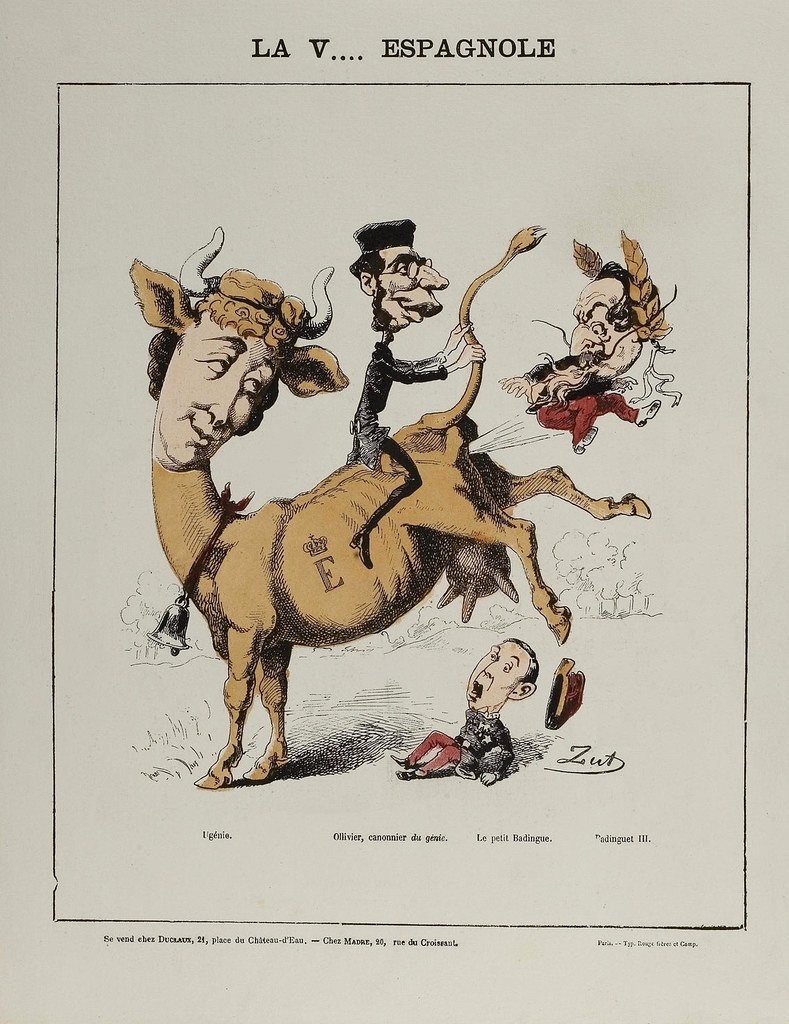
Empress Eugénie depicted as a cow, tossing her family in the air whilst being ridden by Émile Ollivier. Spanish noblewoman and wife of Napoleon III, Eugénie de Montijo, was "largely blamed for the fiasco of the French intervention in Mexico and the eventual death of Emperor Maximilian I of Mexico. Critics claimed that she had encouraged French involvement as a means of keeping herself busy and to get over her husband's affairs."
Hand-coloured engraving, again by Alfred Le Petit : some more of his caricatures can be viewed at the V&A.
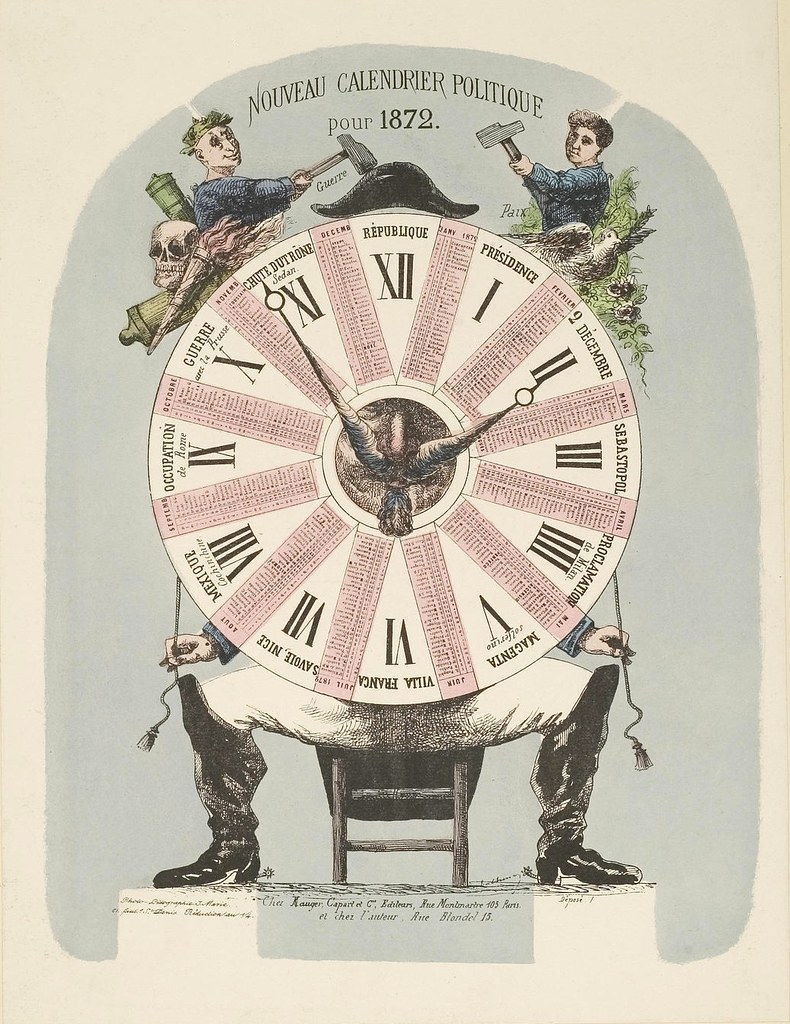
Nouveau Calendrier Politique pour 1872
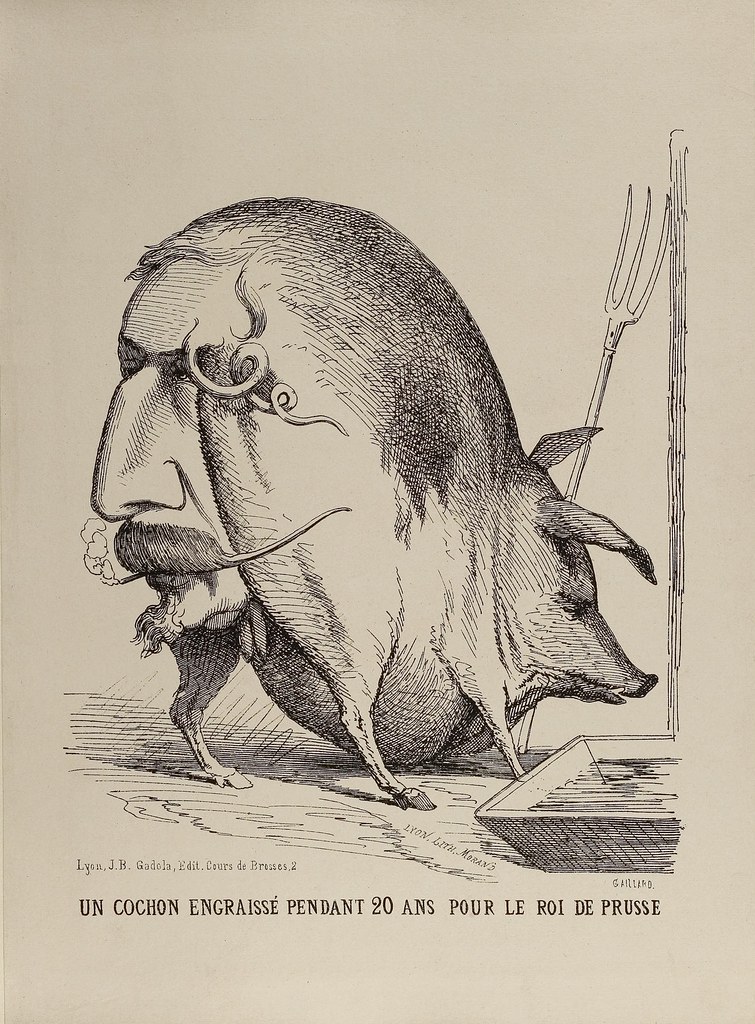
Un Cochon engraissé pendant 20 ans pour le roi de Prusse
(A pig fattened for 20 years for the King of Prussia) - Depicts Napoleon III as a pig's derrière.
Caricature by G Gaillard, lithography by Morand.
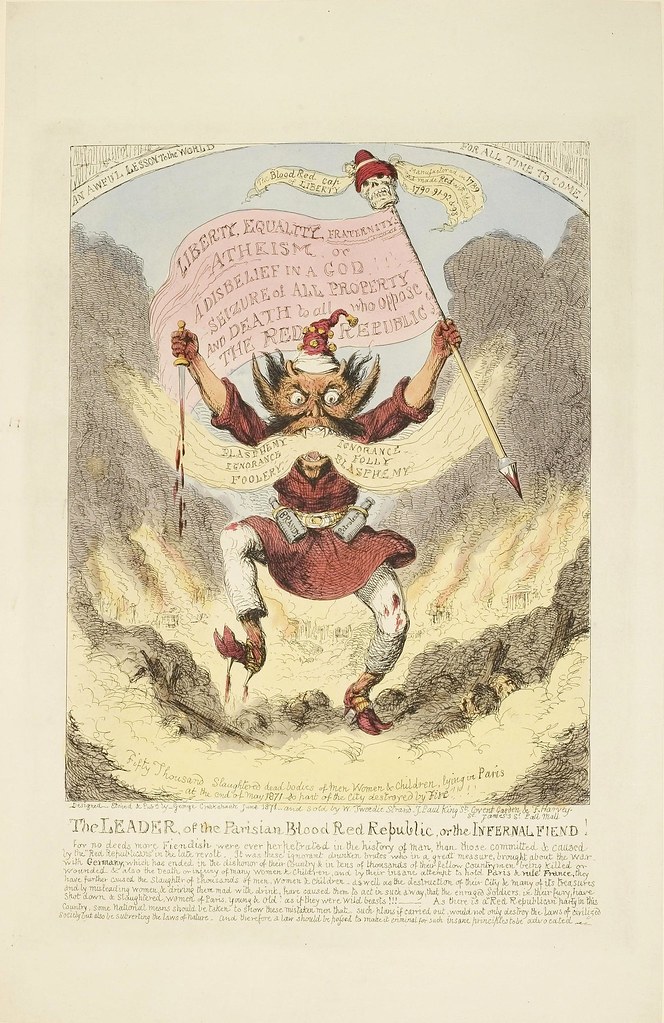
An Awful Lesson to the World for All Time to Come!
Designed, etched and published in London by George Cruikshank, June 1871.
Designed, etched and published in London by George Cruikshank, June 1871.
The leader, of the Parisian blood red republic or, the infernal fiend! ..
for no deeds more Fiendish were ever perpetrated in the history of man, than those committed & caused by the "Red Republicans" in the late revolt. It was these ignorant drunken brutes who in a great measure, brought about the war with Germany, which has ended in the dishonor of their country & in tens of thousands of their fellow countrymen being killed or wounded & also the Death or injury of many women & children, as well as the destruction of their City & many of its treasures and by misleading women & driving them mad with drink, have caused them to act in such a way, that the enraged Soldiers in their fury, have shot down & slaughtered women of Paris, young and old as if they were wild beasts!!!
As there is a "Red Republican" party in this country, some national means should be taken to show these mistaken men that such plans if carried out, would not only destroy the Laws of Civilized Society but also be subverting the laws of nature. And therefore a law should be passed to make it criminal for such insane principles to be advocated.
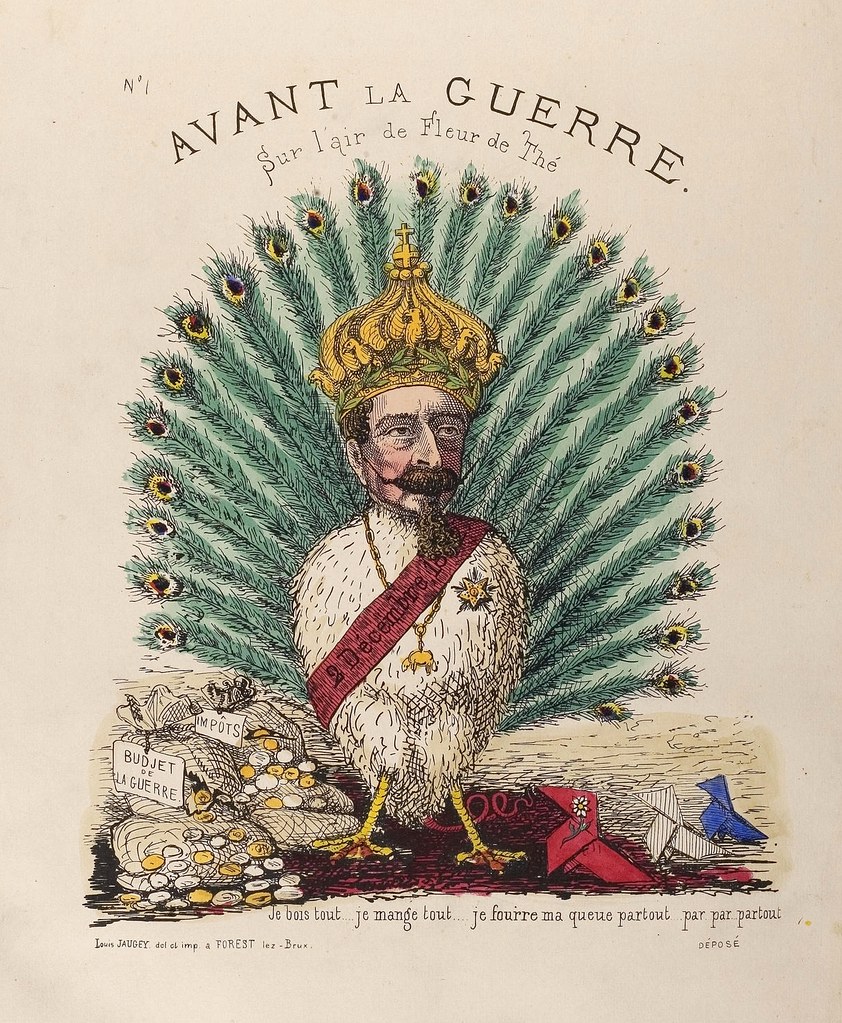
Avant la guerre sur l'air de fleur de thé
(my guess): Before the war, with the air of a peacock
*See comment by Grégoire below*
je bois tout .... je mange tout .... je fourre ma queue partout par par partout
(but now?) I drink and eat everything and get my tail caught everywhere
*See comment by Grégoire below*
je bois tout .... je mange tout .... je fourre ma queue partout par par partout
(but now?) I drink and eat everything and get my tail caught everywhere
Hand-painted engraving by Louis Jaugey whose illustrative output was at one time banned for obscenity.
"Napoleon III struts resplendent as a peacock with a sash lettered 2 Décembre, 1852, the date on which he took the title Emperor, across his breast. To his right are several bags of gold, one labelled Budjet de La Guerre and another Impôts, a reference to the heavy taxes imposed to raise money for the quest for La Gloire abroad. The daisy on the diagrammatic cardboard horse to his left refers to his mistress Marguerite Bellanger" [source]
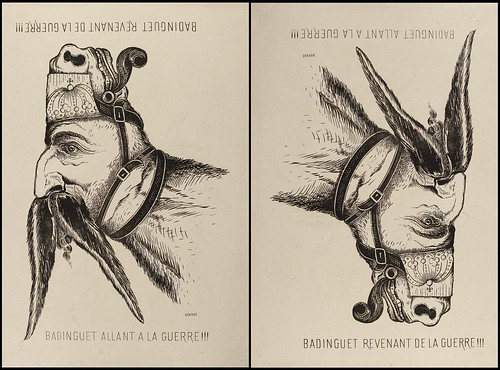
Badinguet Allant a la Guerre - Badinguet Revenant
badinguet going to war
ƃuıuɹnʇǝɹ ʇǝnƃuıpɐq
badinguet going to war
ƃuıuɹnʇǝɹ ʇǝnƃuıpɐq
Napoleon III was nicknamed Badinguet after the workman he is said to have impersonated when he escaped from the Fortress of Ham in 1846. He had been condemned to perpetual imprisonment there for his unsuccessful invasion of France at Boulogne six years earlier. Needless to say, the name Badinguet was intended to humiliate the Emperor-President.
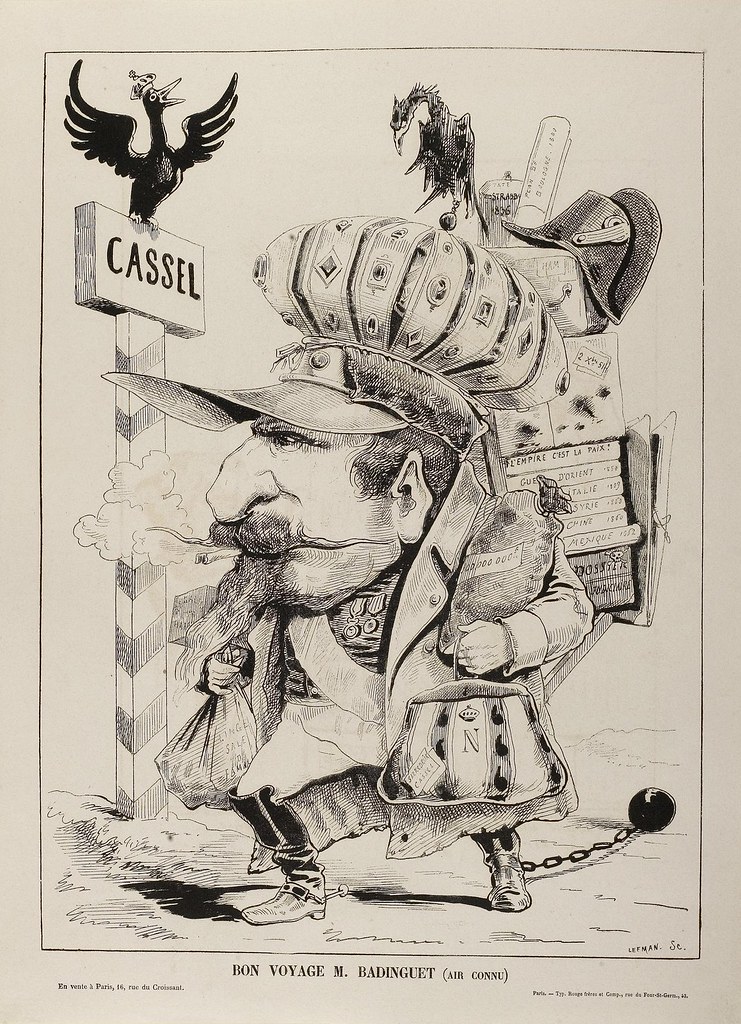
Bon Voyage M. Badinguet (air connu)
Bon Voyage Dr. Badinguet (a popular tune)
Design attributed to Pépin.
Bon Voyage Dr. Badinguet (a popular tune)
Design attributed to Pépin.
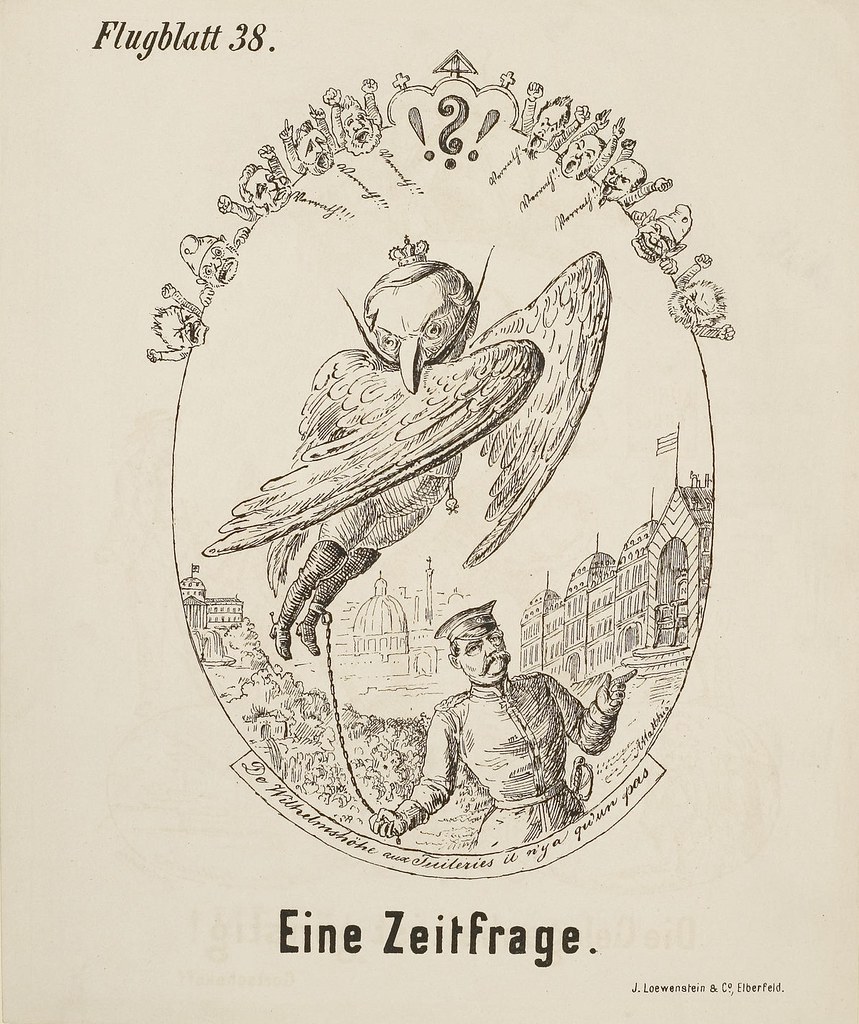
Eine Zeitfrage
A question of time
(The Tuileries Palace is in the background)
{Mr Burns, is that you?}
A question of time
(The Tuileries Palace is in the background)
{Mr Burns, is that you?}

Versailles ~ Paris
Embrassons nous .. et que ça finisse.....
Let's embrace .. and this will all be over.....
Embrassons nous .. et que ça finisse.....
Let's embrace .. and this will all be over.....
I'm not certain, but I think this depicts Adolphe Thiers (French leader responsible for suppressing the revolutionary Paris Commune) and the Prussian Chancellor, Otto von Bismarck. Thiers' patriotism had been called into question because he favoured negotiation rather than war with the Prussians.
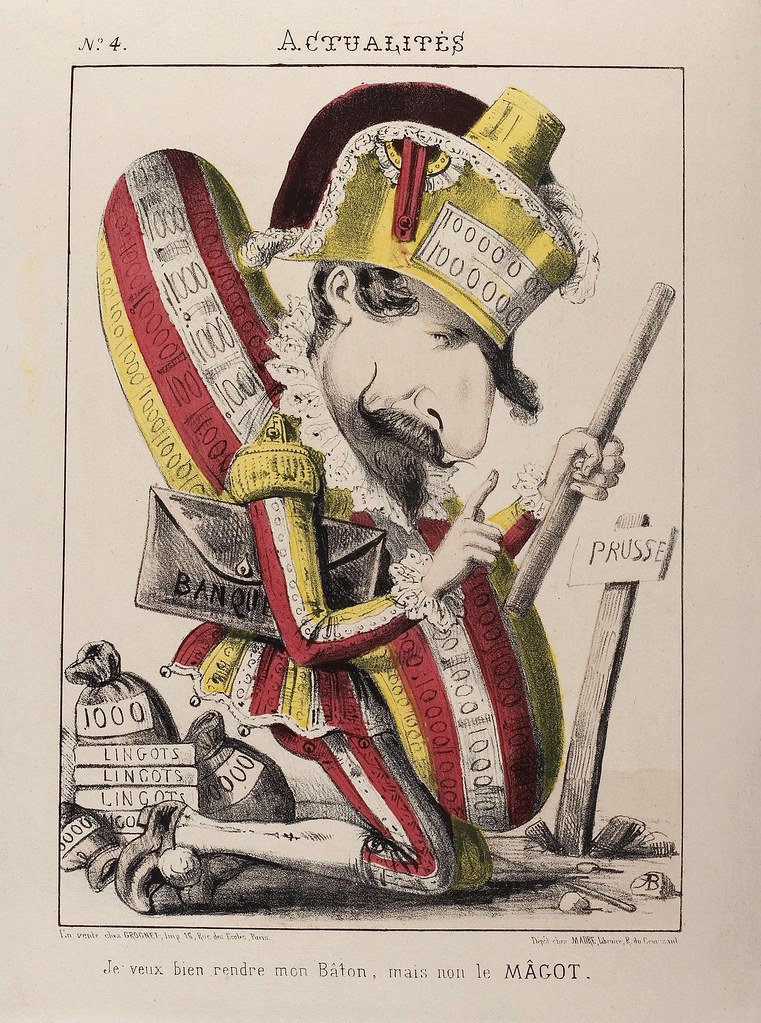
Je veux bien rendre mon bâton, mais non le mâgot
News: ?I would give up the stick, but not the loot
News: ?I would give up the stick, but not the loot
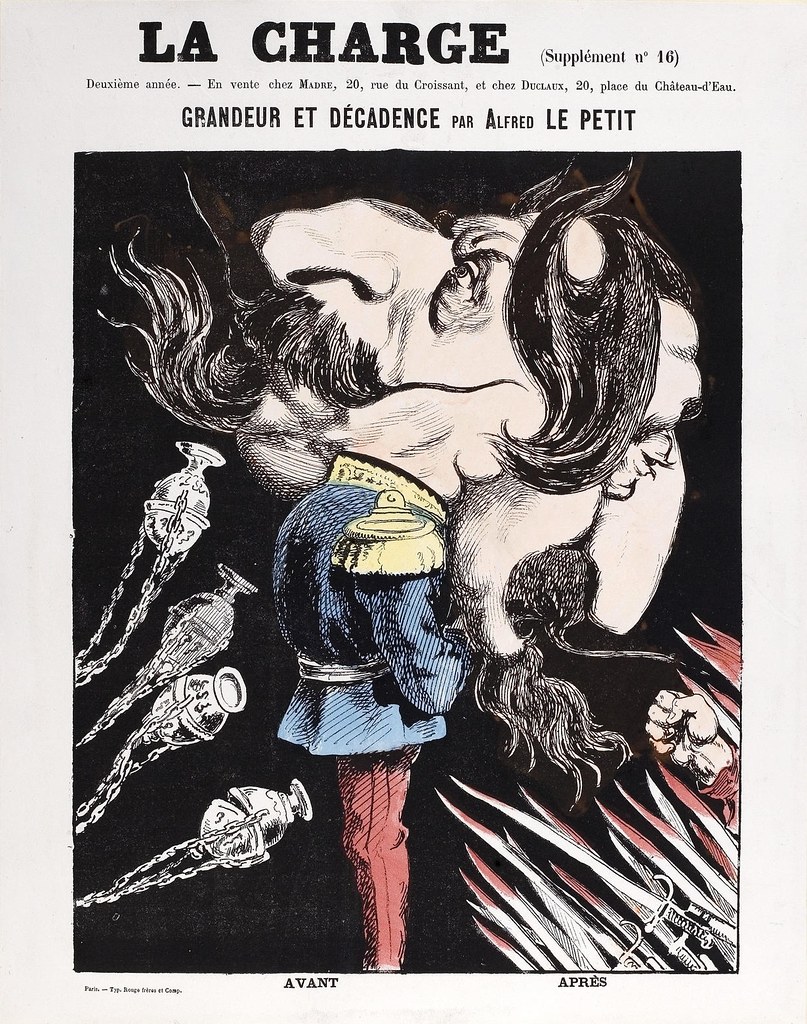
'La Charge' - Grandeur et Decadence par Alfred Le Petit
The rise and fall of Napoleon III (lithograph)
The rise and fall of Napoleon III (lithograph)
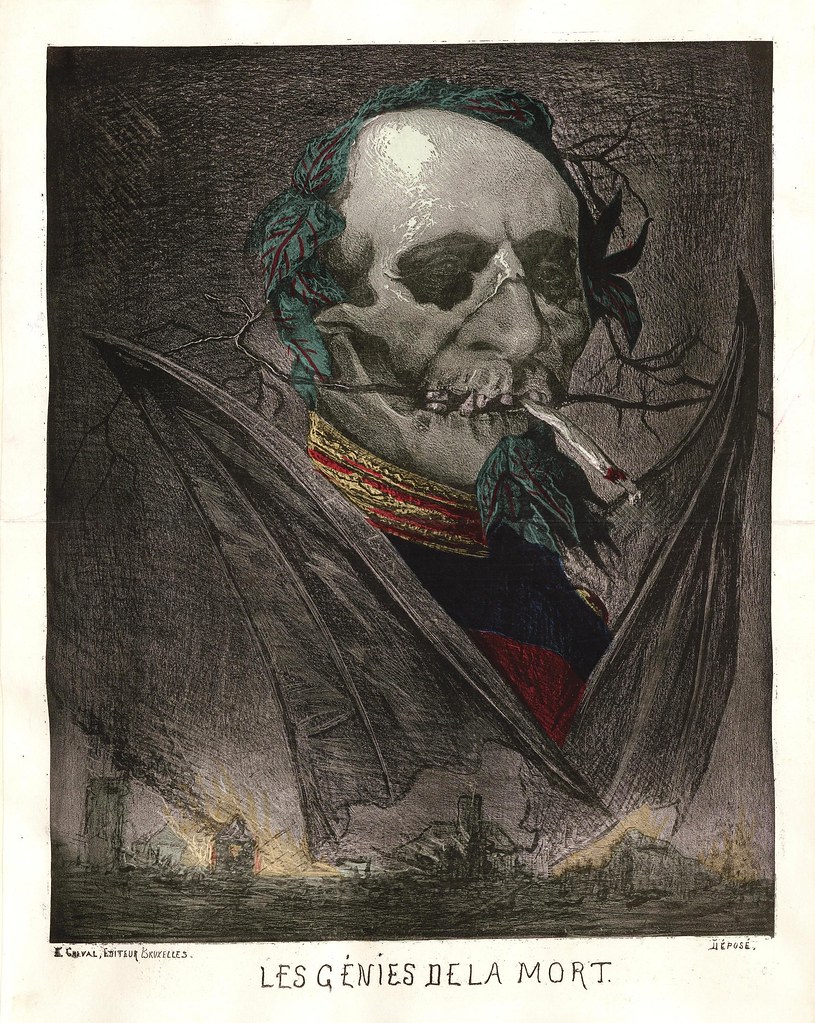
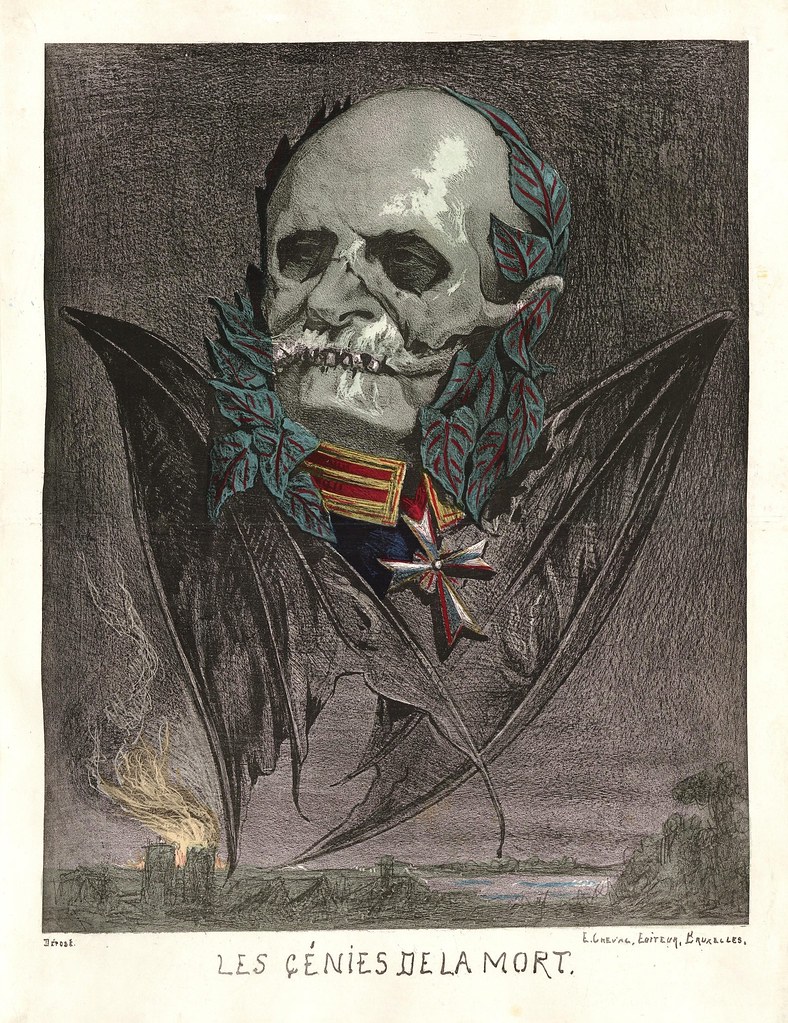
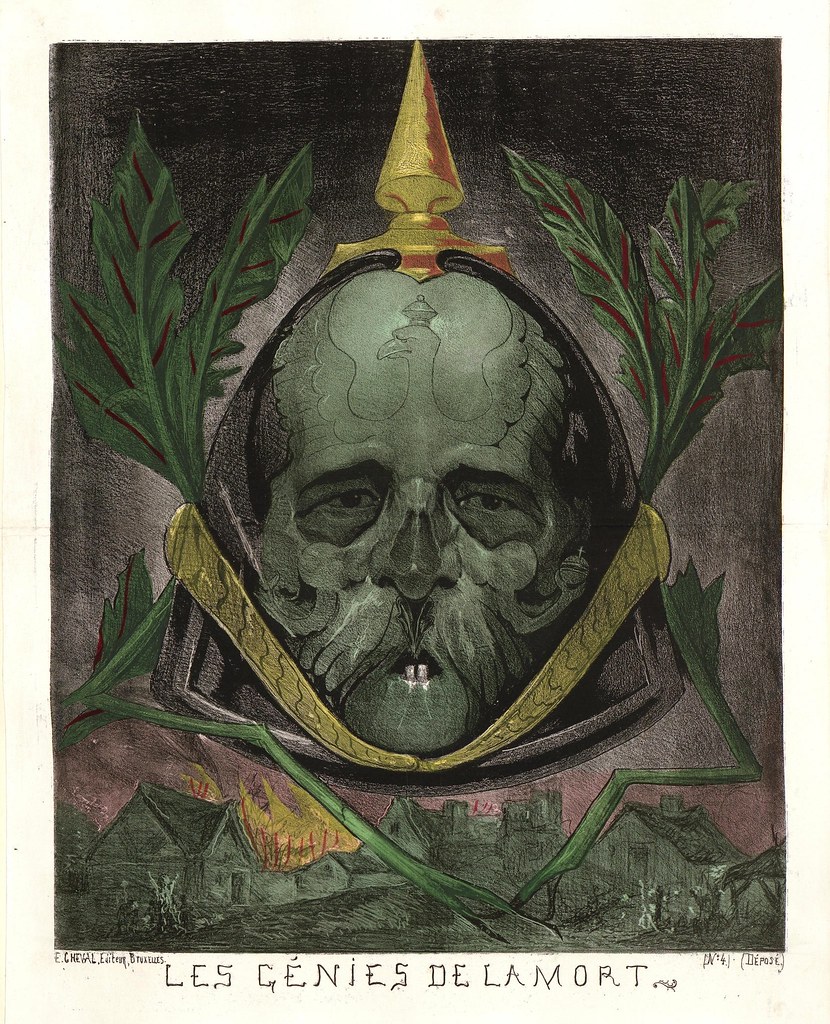
Les Genies de la Mort
Geniuses of death - a sinister group of lithographs by Edmond Jean Baptiste Guillaume (Bismarck is seen in the third image). Guillaume's work was said to have been an influence on Odilon Redon.
(click through for enlarged versions: all images above have been modestly background cleaned. Some of the remarks and translations above may not always be strictly accurate -- all care taken -- so please pass on any corrections)
Among their art journals collection, the University of Heidelberg have a set of nine volumes of caricatures relating to the Franco-Prussian war and Paris Commune of 1870-1871.
The series is called: 'Collection de Caricatures et de Charges Pour Servir à l'Histoire de la Guerre et de la Révolution de 1870-1871' -- click through on any volume and then on any of the links below 'Inhalt', then 'vorschau' for thumbnail images. {Vol.9 is not safe for work} The image quality is very good considering they appear to be printing from secondary sources. The multi-volume series may have been a limited edition private portfolio: it doesn't seem to turn up as an official publication.
- An illustrated pdf article in the British Library Journal from 2005 by Morna Daniels - 'Caricatures from the Franco-Prussian War of 1870 and the Paris Commune' - provides some background to the political situation and an overview of the material in the series.
- The Victoria & Albert Museum have a collection of more than one hundred caricatures (many from the present collection).
- Previously: La Caricature.
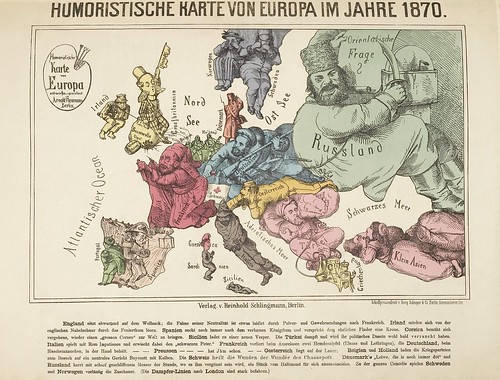



























































8 comments :
Ouch! slain, by the pen!!!
These are fascinating. Quite ingenious as well. I had no idea Napoleon III was so exceedingly vilified at the end. It stands to reason but I had never seen the manifestations.
Today's subject is part of the research I am conducting for a while, but without huge succes because of the limited number of museums or printed books over here.Can you give me a bit of advice about where to look for caricatures in the time of Charles the IVth of Spain and the influence of Napoleon over the Iberic space?
Simona, Brown University Napoleon Satires gives about 40 results for 'spain'.
These are wonderful PK! Rekindles great appreciation for the days when the cliché of the pen being mightier than the sword ruled and thinking and drawing were not mutually exclusive. Jean Cocteau had it right when he said that "drawing is merely handwriting that has been untied and retied in another fashion..."
What a splendid post! So many informations and visual footage. Bravo!
I can see why Guillaume's work has been an influent to Redon, they have something in common ..
Great post indeed ! For the peacock image :
The proper traduction would be "on the air (tune) of the tea leaf". The tea leaf was probably a song at the time. At the time, every time someone was writing a song, he didn't create a new melody. Instead, he wrote lyrics on an existing melody, which was already known by everybody. As there was no radio, it was an easy way to disseminate new songs, which had often a political meaning. There was even a book, called "la clef du caveau" (the key of the cave, "Le Caveau" being an important place where song writers came to sing their new songs in Paris), which was edited regularly, and in which people could find the most important tunes of the moment. I even found some scores from the 1920's in my grand grand mother's house in Provence, where this system was still used.
That's why the text is written "je bois tout .... je mange tout .... je fourre ma queue partout par par partout". Note that "je fourre" is very very very rude speaking of a tail. And the repetition of the first syllab of "partout" (everywhere) : "par par..." is probably to fit with the melody of the song (where repetitions at the end of the verse is meant to have a comic effect).
Thank you very much Grégoire! I didn't believe (or at least, understand) the web translation - I thought -fleur du thé- was a colloquial expression for peacock.
Post a Comment
Comments are all moderated so don't waste your time spamming: they will never show up.
If you include ANY links that aren't pertinent to the blog post or discussion they will be deleted and a rash will break out in your underwear.
Also: please play the ball and not the person.
Note: only a member of this blog may post a comment.